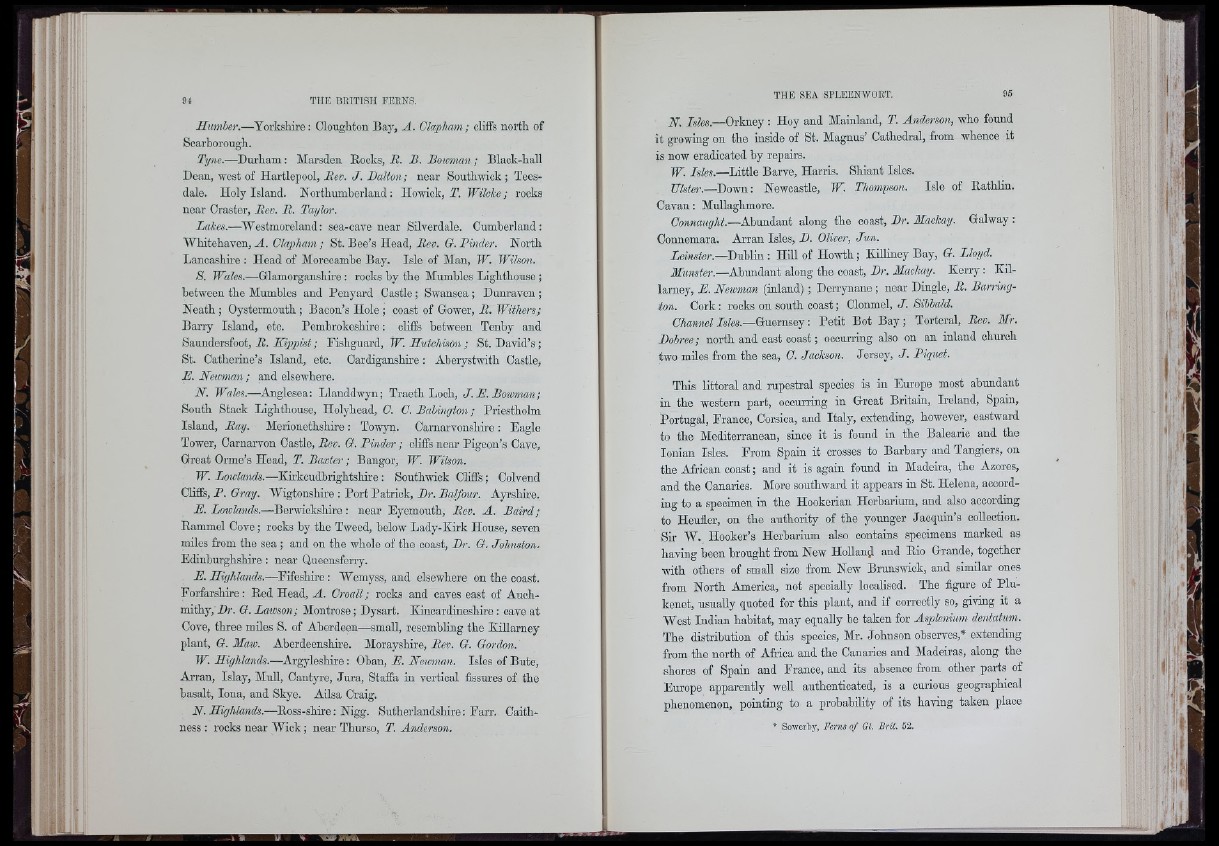
il I
'! y.'
J r ■
•i
■S ' ■ :
I '
i i,
«
w
f t, 1
iii
Humber.—Yorksliiro: Clougliton Ba}’, A. Clapham; cliffs north of
Scarborough.
Tyne.—Durham: Marsden Eocks, II. B. Bowman; Blaok-hall
Doan, west of Hartlepool, Rev. J. Ballon; near Southwick ; Tees-
dale. Holy Island. Northumheiiand: Howiok, Y. Wilcke; rooks
near Crastor, Rev. R. Taylor.
Lakes.—Westmoreland; sea-oave near Silverdale. Cumberland:
Whitehaven, A. Clapham; St. Bee’s Head, Bev. O. Binder. North
Lancashire : Head of Morocambe Bay. Isle of Man, W. Wilson.
S. Wales.—Glamorganshire: rooks by the Mumbles Lighthouse;
between the Mumbles and Penyard Castle; Swansea; Dunraven ;
Neath ; Oystermonth ; Bacon’s Hole ; coast of Gower, B. Withers;
Barry Island, etc. Pembrokeshire: cliffs between Tenby and
Saundersfoot, it. YTpyiisri' Fishguard, W. Hutchison; St. David’s;
St. Catherine’s Island, etc. Cardiganshire: Aberystwith Castle,
E. Newman; and elsewhere.
N. Wales.—-Anglesea: Llanddwyn; TAaeth. hooh, J .E . Bowman;
South Stack Lighthouse, Holyhead, C. C. BaUngton; Priestholm
Island, Ray. Merionethshire : Towyn. Carnarvonshire: Eagle
Tower, Carnarvon Castle, Bev. O. Binder ; cliffs near Pigeon’s Cave,
Great Orme’s Head, T. Baxter; Bangor, W. Wilson.
W. Loiciands.—Kirkcudbrightshire; Southwick Cliffs; Colvend
Cliffs, P . Gray. Wigtonshire : Port Patrick, Dr. Balfour. A}Tshire.
E. Lowlands.—Berwickshire : near Eyemouth, Bev. A. Baird;
Eammel Cove; rocks by the Tweed, below Lady-Kirk House, seven
miles from the sea ; and on the whole of the coast, Br. G. Johnston.
Edinburghshire; near Queensferry.
E. Highlands.—Fifeshire: Wemyss, and elsewhere on the coast.
Forfarshire: Eed Head, A. Croall; rooks and caves east of Auoh-
mithy, Pr. G. Lawson; Montrose; Dysart. Kincardineshire : cave at
Cove, three miles S. of Aberdeen—small, resembling the KiUarney
plant, G. Maw. Aberdeenshire. Morayshire, Rev. G. Gordon.
W. Highlands.—Argyleshire: Oban, E. Newman. Isles of Bute,
Arran, Islay, Mull, Cantyre, Jura, Staffa in vertical fissures of tho
basalt, Iona, and Skye. Ailsa Craig.
N. Highlands.—Eoss-shire: Nigg. Sutherlandshire: Farr, Caithness
: rooks near Wick; near Thurso, T. Anderson,
N. Isles.—Orkney : Hoy and Mainland, T. Anderson, who found
it growing on the inside of St. Magnus’ Cathedral, from whence it
is now eradicated by repairs.
W. Isles.—Little Barve, Harris. Shiant Isles.
Ulster.—Down: Newcastle, W. Thompson. Isle of Eathhn.
Cavan: Mullaghmore.
Connaught.—Abundant along the coast, Br. Mackay. Galway :
Connemara. Arran Isles, B. Oliver, Jan.
Leinster.—Dublin : Hill of Howth; Killiney Bay, G. Lloyd.
Munster.—Abundant along the coast, Br. Mackay. Kerry: Killarney,
E. Newman (inland) ; Derrynane ; near Dingle, R. Barrington.
Cork: rocks on south coast; Clonmel, J . Sibbald.
Channel Isles.—Qner-nsej: Petit Bot Bay; Torteral, Bev. Mr.
Bobree; north and east coast; occurring also on an inland church
two miles from the sea, C. Jackson. Jersey, J. Figuet.
This littoral and rupestral species is in Europe most abundant
in the western part, ooourring in Great Britain, Ireland, Spain,
Portugal, France, Corsica, and Italy, extending, however, eastward
to the Mediterranean, since it is found in the Balearic and the
Ionian Isles. From Spain it crosses to Barbary and Tangiers, on
the African coast; and it is again found in Madeira, the Azores,
and the Canaries. More southward it appears in St. Helena, according
to a specimen in the Hookerian Herbarium, and also according
to Heufler, on the authority of the younger Jacquin’s coUeotion.
Sir W. Hooker’s Herbarium also contains specimens marked as
having been brought from New Holland and Eio Grande, together
with others of small size from New Brunswick, and similar ones
from North America, not specially localised. The figure of Plu-
kenet, usually quoted for this plant, and if coiTOctly so, giving it a
West Indian habitat, may equally be taken for Asplenium dentatum.
The distribution of this species, Mr. Johnson observes,* extending
from the north of Africa and the Canaries and Madeiras, along the
shores of Spain and France, and its absence from other parts of
Europe apparently weU authenticated, is a curious geographical
phenomenon, pointing to a probability of its having taken place
Sowerby, Ferns o f Gt. Brit. 52.
i‘.7l
I ..il
(
■ - l i ' l
■ k\
-ilt